Dipak Kaphle1, Dinesh Panthi2
1Research Centre, Nepal Sanskrit University, Kathmandu, Nepal
2Department of Mathematics, Valmeeki Campus, Nepal Sanskrit University, Kathmandu, Nepal
Correspondence to: Dipak Kaphle, Research Centre, Nepal Sanskrit University, Kathmandu, Nepal.
| Email: |  |
Copyright © 2021 The Author(s). Published by Scientific & Academic Publishing.
This work is licensed under the Creative Commons Attribution International License (CC BY).
http://creativecommons.org/licenses/by/4.0/

Abstract
Located between China and India in South Asia, Nepal is Known as the country of mount Everest and the birth place of Gautam Buddha. The history of the movement of people from the land of Nepal has been confirmed by the history of the geographical Nation in the Course of the development of Eastern Civilization. At present in Nepal, foreigners are easily provided different type of visa to facilitate entry and presence in Nepal. Due to the open border between Nepal and India, visa is not mandatory when traveling to another Country, so travel can be done on the basis of other identity cards. Between1964 to 2000, about 20 million foreigners have paid official visits to Nepal, while in the last 15 years, about 10 million foreigners have visited Nepal. The recent global outbreak of the Corona epidemic has seen a decline in foreign arrivals. As the hospitality of the guests is the culture identity of Nepal, the necessary assistance from the concerned governmental and non-governmental sector has been coordinated and regulated to fulfill the purpose of the visit to all the foreigners visiting Nepal. As about 3.5% of the world's Population travels to another Country every year, the study of this article is expected to help to know the statistical analysis of the presence of foreigners in Nepal and make Nepal a tourist destination.
Keywords:
Foreigners, Immigration, Statistics, Arrival, Remittance, Percentage, Figure, Visa, Table
Cite this paper: Dipak Kaphle, Dinesh Panthi, Statistical Analysis of the Presence of Foreigners in Nepal, American Journal of Mathematics and Statistics, Vol. 11 No. 2, 2021, pp. 49-57. doi: 10.5923/j.ajms.20211102.04.
1. Introduction
Nepal is located between two big countries India and China in south Asia. Nepal, known as a landlocked country, is in place in terms of population and geography amongst other. Nepal is also known around the world as the country of the world's highest peak, Mount Everest, and the birthplace of Gautama Buddha.With the long history of the development of civilization and culture of Nepal, it is also known for the main place of development of Eastern civilization (Amatya, 2011). It can be estimated that, from a very long time, people from neighboring countries have been moving and settling in the land of Nepal with ancient historical background. Even when the political boundaries of the countrieswere not clear, there are facts that people migrated from place to place to meet their daily needs and to avoid divine calamities.In the course of the development of Hindu civilization in the eastern civilization, it has been found that the ancient sages of Nepal were practicing the knowledge they acquired, the philosophy they adhere to and worshiping for ages. The existence of the Hindu temple of Aradhyadeva Pashupatinath in Nepal, the writing of the ancient scripture Ramayana in the Himalayas and the birth of Gautama Buddha, the promoter of Buddhism philosophy in Kapilvastu, confirm the fact that people have been migrating to Nepal from various places.Even though such migration to Nepal have been observed for a long time, unofficial recording of foreigners' movement had been going on since the time of Bhimsen Thapa, the first Prime Minister of Nepal. In 1779 AD, the then King Prithvi Narayan Shah formally started the management of foreigners by setting up an institutional mechanism called "Jassi Room" to look after the affairs of foreigners (Upadhyaya, 2016). In the process of formally archiving foreigners and to expand and strengthen relations with foreign countries, the statistics show that about 20 million foreigners have formally visited Nepal from the past to 2020 (Nepal tourism statics 2019).
2. Visas Available to Foreigners in the Context of Nepal
In order to regulate and control the entry, presence and departure of foreigners within Nepal, rules and regulations related to immigration management have been issued. Anyone who is not an immediate citizen of Nepal is considered a foreigner according to the law. The process of entry, presence and departure of foreigners within Nepal is called immigration (Immigration Act, 1992). A permit issued by the government to foreigners for entry and presence in Nepal is called a visa. Provision is made for the issuance of a visa for any passport or travel document, travel permit letter issued by the government of any country to its citizens or laissez passer issued by the United Nations for its employees. There is an arrangement to provide visa for foreigners to enter Nepal from the immigration department and its subordinate offices and Nepali missions abroad.Various types of visas are issued to foreigners coming to Nepal according to the purpose of their visit. According to Nepal's Immigration Management Law, a diplomatic visa is provided to a person who obtains a diplomatic passport from any country on a reciprocal basis. A person with a formal passport from another country is usually issued a 30-day formal visa by a government official. Tourist visas are available to foreign tourists visiting Nepal for a maximum of 150 days in a year. Similarly, study visas are available to foreigners who want to study and do research in Nepal's educational institutions according to the program duration. Business visas are issued to the representatives of trade, business and industry organizations in Nepal on the basis of the recommendation of the concerned body.An interim visa is issued to a foreigner entering Nepal to spend the night with a flight ticket to another country via Nepal's international airport. There is also a legal provision to issue non-tourist visas to foreigners who do not belong to a tourist visa or any other visa group. Non-resident Nepali visas will be available for foreigners of Nepali origin residing abroad if they wish to reside in Nepal or do business or study, teach or research. There are free and paid visas based on the nature of the visa and the identity, status and reciprocity of the foreigner coming to Nepal. Visa fees are levied according to Nepalese law but adjusted and changed as per the decision of the government.Due to the about 1850 kilometers open border of Nepal with India, the visa system is not mandatory for the movement of citizens between Nepal and India, but passports and visas are mandatory for the entry, presence and departure of citizens of other countries. It seems that the Immigration Department has made the necessary information about the method and process of obtaining visa for Nepal public on its website.
3. Statistics on the Presence of Foreigners in Nepal
Nepal, which has diplomatic relations with 168 countries of the world, has been attracting foreigners for a long time. According to the official statistics, the number of foreigners who came to Nepal in 1964 is 9526 and this yearly increasing number reached to 1197191 in year 2019. Analyzing the statistics of foreigners who have come to Nepal for the last 15 years, the situation is as follows:Table 1. Statistics of routes and average stay of foreigners who came to Nepal from 2005 to 2019
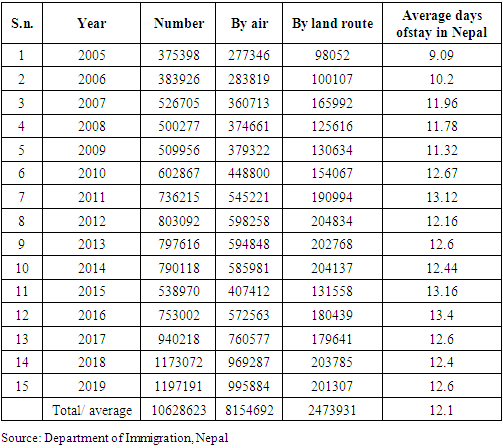 |
| |
|
According to the above presented table, 10628623 foreigners have visited Nepal in different visa groups in the last 15 years. Internationally, both air and land routes to Nepal appear to have been used. About 77% of foreigners have formally entered Nepal by air and about 23% by land. Although the number of Indian nationals visiting Nepal for pilgrimage, business and informal visits is high, it is difficult to present a statistical record due to the lack of formal records management.Analyzing the statistics of the presence of foreigners in Nepal for the last 15 years and referring to the figure 1, even though there is growing tendency in number, the number seems to have increased and decreased. Due to the great earthquake in Nepal in 2015, the presence of foreigners seems to have decreased somewhat. Similarly, figure 2, the average stay of foreigners in Nepal seems to be stable with a modest increase.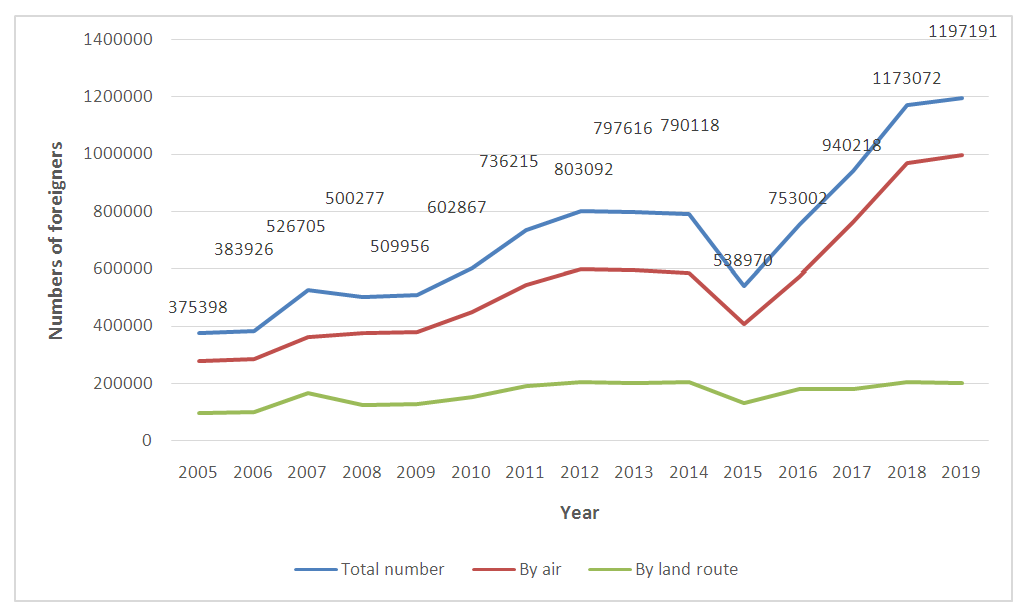 | Figure 1. Number of foreigners in different years with routes the used for entry |
 | Figure 2. Average days spent by foreigners |
According to table 2, the number of men, as compared to women, coming to Nepal seems to be increasing. Between 2005 and 2019, the number of women visiting Nepal was higher in 2011 alone. On an average, about 56% of men and 44% of women foreigners visit Nepal.Aforementioned figure 3 & 4 depicts the comparative growth rate of women and men as foreigners coming to Nepal, which seems to have increased over the time with normal fluctuations. Further analyzing the age of foreigners coming to Nepal, it is approximately 7% under 15 years, 22% of 16 to 30 year olds, 30% of 31 to 45 year olds, 25% of 46 to 60 year olds, 13% of over 60 year olds and about 3% of unrecorded age foreigners have come to Nepal.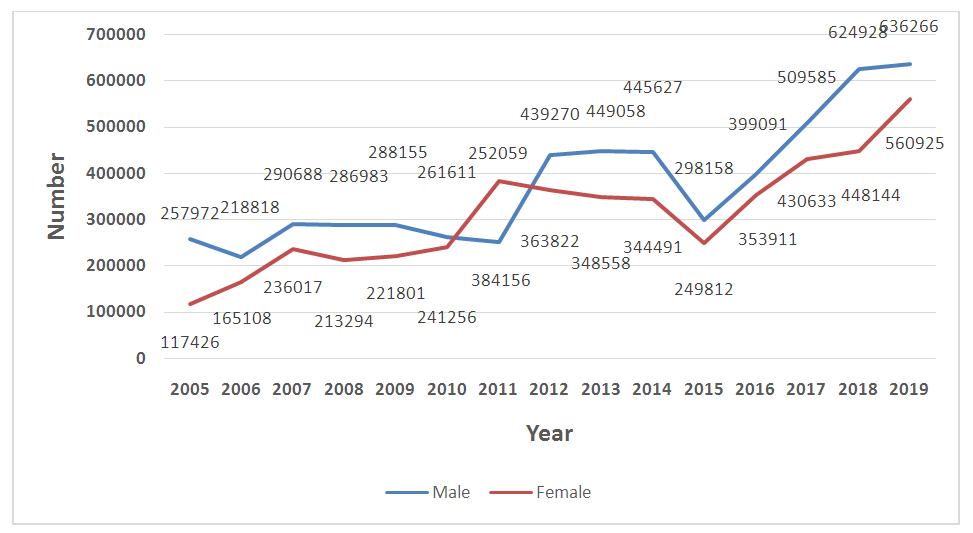 | Figure 3. Arrival status of foreigners on gender basis (in number) |
 | Figure 4. Arrival status of foreigners on gender basis (percentage distribution) |
 | Figure 5. Arrival status of foreigners in age group in different years (in percentage) |
Foreigners come to Nepal from about 170 countries according to 2018 official record (Government of Nepal). The number of foreigners coming to Nepal from many countries is increasing every year. The major counts are of India, China, USA, Sri Lanka, UK, Japan, Germany, Australia, France and Thailand. About 60% of foreigners come to Nepal from these 10 countries while about 40% of foreigners come to Nepal from other countries. About 35% of foreigners coming to Nepal are from India, China and the United States (Immigration Bulletin, 2017).Table 2. Movement status of foreigners on the basis of gender
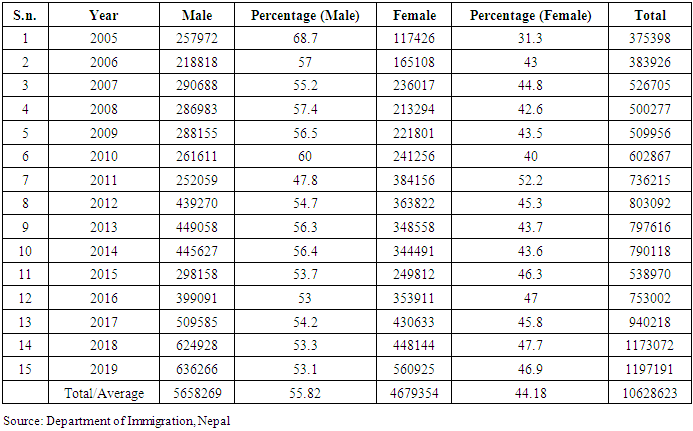 |
| |
|
There are immigration offices at Tribhuvan International Airport, Kathmandu and Jhapa, Ilam, Morang, Parsa, Rasuwa, Rupandehi, Banke, Kailali, Kanchanpur, Sindhupalchok and Humla districts. There is an Pokhara Immigration Office to facilitate foreigners, while many organizations in the government and non-government sectors work in the field of facilitating the management of foreigners.
4. Purpose of Foreigners Coming to Nepal
The purpose of foreigners coming to Nepal is also clear from the nature of the visas provided by the government to foreigners for entry, presence and departure. Nepal has an on-arrival visa system for citizens of many countries so as to easethem to enter Nepal as compared to other countries. Analyzing the purpose of foreigners' visit to Nepal in the last 15 years, it is found that about 51% of foreigners come to Nepal for holidays. Similarly, with the abundance of mountains, mountainous regions and trekking areas in Nepal, the number of foreigners coming for mountaineering and trekking seems to be around 13%.Relatively low, about 3% of the foreigners has come to Nepal for business. Due to the presence of the Hindu temple Pashupatinath and the birthplace of Gautama Buddha, the epitome of world peace and the Buddhism, and due to many other religious places, about 15% of the foreign pilgrims has come to Nepal come for religious visits. Foreigners for various government and non-government jobs is about 3%, for various gatherings and other formal events is about 2%, while for other personal purposes like cross-border marriage, visiting relatives is about 1%. Visit for work, study, teaching, research or any other miscellaneous work counts about 12%.An expatriate who leaves his or her homeland or country and seeks refuge in another country is a refugee (Epstein Gils and Gang Ira N, 2010). Although Nepal is not an abiding party to the 1951 United Nations Convention Relating to the Status of Refugees, there are a small number of refugees in Nepal treated with humanitarian response. Of the Bhutanese refugees who have come to Nepal since 1990, 112,229 have been resettled in 2017 in eight countries: United States, Canada, Australia, New Zealand, Denmark, Norway, the United Kingdom and the Netherlands (Immigration report 2019). A small number of foreign refugees, including some Bhutanese refugees, Tibetans refugees and asylum seekers from other countries, are still in Nepal (Global report 2019). With a population of about 30 million, geographically landlocked, economically underdeveloped, culturally segregated and socially diverse country of caste, creed, religion, language and costume, adjustment and management of refugees could have been difficult in which United Nation Organizations support has been remarkable.
5. Institutional Arrangements in Nepal for the Management of Foreigners
Institutional and structural arrangements have been made in the government and non-government sectors to manage the entry, presence and departure of foreigners in Nepal. Various tourism businesses are operating with the objective of making foreigners'stayeasy in different parts of the country, provide services as per their wishes and needs, introduce Nepal to the world through the foreigners as they return and to support Nepal's economic development through tourism industry. Trekking agencies, hotels, restaurants, tourist guides, tour operators, mountaineering facilitation bodies, rafting facilitation bodies, air transport facilitation bodies, regulatory bodies and security management bodies and other concerned entities are there to cater the hospitality. Acts, rules and policy and legal provisions have been made regarding the management of foreigners. Committing illegal activities by visitors are offensive according to Nepalese law. The following are the statistics of tourism industry businesses and hotels in Nepal.Table 3 has presented the statistics of the organizations operating in Nepal to assist and facilitate foreigners in the last 7 years in Nepal. These organizations work in their respective fields to provide services to the foreigners coming to Nepal as per their expectations. Similarly, the table 4 presents categories of hotel, their numbers and the beds available in total. Nepal, which has been making continuous progress in tourism sector, has been increasing its tourism infrastructure, hotel business and other institutional businesses to facilitate foreigners; figure 6 and 7 also substantiate that.Table 3. Tourism industries and businesses in Nepal
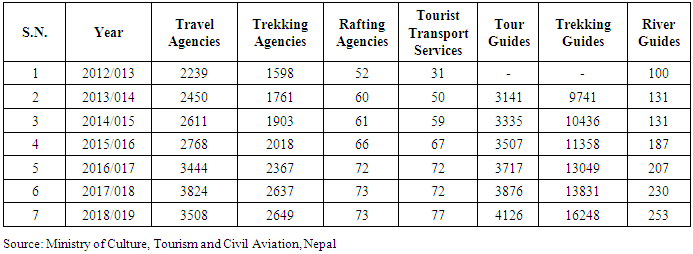 |
| |
|
Table 4. Details of hotels in Nepal
 |
| |
|
 | Figure 6. Statistics of tourism industry and businesses in Nepal |
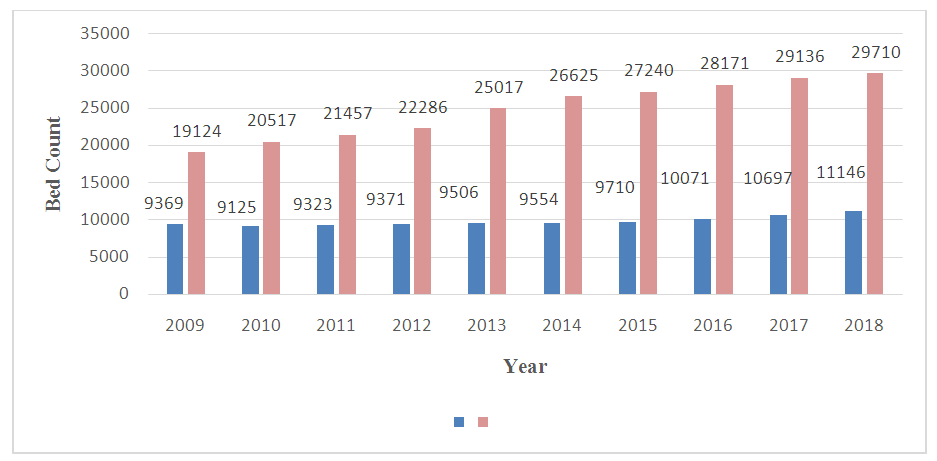 | Figure 7. Number of beds in hotels in Nepal |
 | Figure 8. Growth trends of hotel's number in Nepal |
6. International Movement of Foreigners and the Environment of Nepal
The movement of people from one country to another for a period of time is associated with international traffic. Generally, people go from one country to another to escape various natural and man-made disasters, to participate in recreational activities, to exchange happiness or for business and family work (ICRC, 2017). The largest number of such movement of people accounts for tourism. Tourism, which began in Western Europe in the 17th century, is now developing into a tourism industry and business in all countries of the world (Open Journal of Social Sciences, 2020, 8, 106-116). According to the World Migration Report published by IOM UN Migration in 2020, the state of global human migration in 2000 and 2020 is as follows:Table 5. Conditions of movement in the world
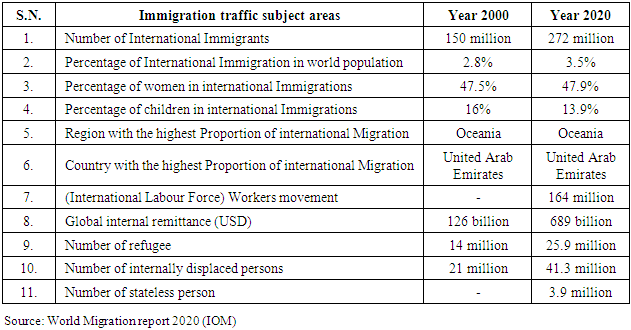 |
| |
|
With adoption of Nepal's open economy, global changes in economic policies and friendly relations with the member countries of the United Nations including other countries, there is significant increase in number of Nepalese travelling to countries of the world. Table 5 compares the state of human movement around the world in between 20 years' period. About 3.5 percent of the world's population moves from one country to another every year. About 30 percent of Nepal's Gross Domestic Product (GDP) comes from remittances, and Nepal is one of the top 10 countries in the world for remittances (Adhikari, Jagannath and Gurung, Ganesh 2010 ). The fact that both Nepalese's movement to live abroad and the regular movement of foreigners to Nepal contributed to Nepal's identity globally.
7. Conclusions
The themes of this article are presented in a descriptive and numerical manner using statistical methods to describe the statistics of foreigners published by institutional bodies. About 45% of the foreigners who come to Nepal are women, their average stay in Nepal is about 13 days and the per capita expenditure per day is about 50 US dollars. Nepal a member of the United Nations, has friendly diplomatic relations with 168 countries around the world and foreigners from around 170 countries visit Nepal every year. Nepal has a high rate of remittances and as a continuation of foreigners coming here and Nepalis going abroad, it seems that Nepali culture is being established with the culture of different countries. This article is believed to be helpful in conducting further study and research on foreigners as it provides fact based analysis to manage the entry, presence and departure of foreigners in Nepal.
References
| [1] | Adhikari, Jagannath and Gurung Ganesh (2010), Foreign employment, Remittance and its impact on the Nepalese Economy, Kathmandu: International Organization for Migration. |
| [2] | Amatya, Safalya (2011), Archeology, History and Culture, Kathmandu:, Quality Printers Pvt. Ltd. |
| [3] | Epstein Gils and Gang Ira N (2010), Migration and Culture, Germany: Discussion paper No 5123. |
| [4] | Government of Nepal, Immigration bulletin 2017, Kathmandu: Department of Immigration. |
| [5] | Government of Nepal, Immigration Act 1992, Kathmandu: Law Book Management Committee. |
| [6] | Government of Nepal, Nepal Tourism Statistics 2019, Kathmandu: Ministry of Culture, Tourism and Civil Aviation. |
| [7] | Government of Nepal, Immigration report 2019, Kathmandu: Department of Immigration. |
| [8] | ICRC (2017), Migration and displacement Geneva: Editorial board of International Committee of the Red Cross (ICRC). |
| [9] | Open Journal of social science, 2020, 8, 106-116, Immigration of foreigner's world environment and the Nepal Context. |
| [10] | State of peace and security in Nepal (global report 2019), Kathmandu: Government of Nepal. |
| [11] | Upadhyaya, Ram Prasad (2016), Ancient and Middle Ages History of Nepal, Kathmandu:, Ratna Book Store. |











 Abstract
Abstract Reference
Reference Full-Text PDF
Full-Text PDF Full-text HTML
Full-text HTML



